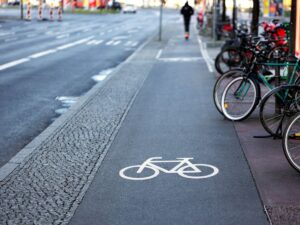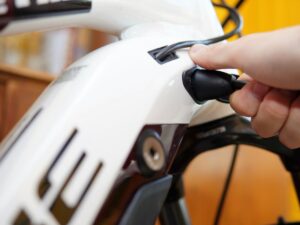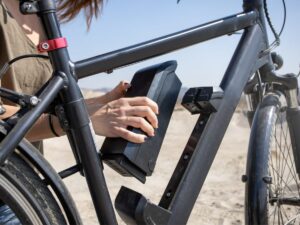
How Fast Do Electric Bikes Go?
- Last updated on

Contents
How fast or slow a typical bike can travel depends on the energy exerted on the pedals. A cyclist can be particularly slow or very fast, based on the amount of effort they put into the journey. The cyclist has total control over their speed and can switch between speeds easily when using a normal bike.
Electric bikes are slightly different. In terms of how fast they travel, they are automated to reach a particular maximum speed. This is different from road bikes or MTBs, as electronic bikes have motors that enhance your riding speed.
On average, electric bikes can reach speeds of 20 miles per hour, but e-bikes can only travel a maximum of 28 miles per hour, and won’t exceed this rate. This remains the case with even more powerful e-bikes, as their motor will have a limit of 28mph.
We’ll cover more about how fast electric bikes are in this post, including the advantages of electric bikes, the various e-bike classes, and how fast each class can travel.
Advantages of Electric Bikes
Electric bikes are modern inventions that are equipped with rechargeable batteries. This helps to increase your riding speed to a maximum of 28mph.
Unlike regular bikes, the e-bike motor does the hard work for the cyclist. Cyclists put in a lot less effort as they don’t need to pedal as hard.
Electric bikes have several advantages, including the following:
Speed
The main difference between regular and electric bikes is the speed. As electric bikes have a motor, they can travel faster, so you can get to your intended destination a lot faster.
Electric bikes can move from 20 mph to 28 mph, along with the additional energy the cyclist pushes on the pedals. Pedaling on electric bikes is uncomplicated and easier, and won’t affect your speed as you do so.
Switching to an electric bike from a regular one helps to conserve your energy, so you are less tired overall.
Also Read: How Much Do Electric Bikes Weigh?
Motor and Design
Electric bikes look very similar to typical road bikes, but if you examine them closely, you’ll see that electric bikes have an electric drive system and motor. A battery, display screen, and motor affect its speed.
Electric bikes may have different motors depending on the one that you choose. You may notice bikes with a rear hub, a mid-drive, or a front hub motor.
Front hub motors are very straightforward electric bike motors, but they do have their limits. You’ll find these on Class 2 electric bikes which have a throttle system.
Rear hub motors are ideal for stabilizing the speed, giving cyclists flexibility as they travel.
Mid-drive motors are in the middle of the bike’s frame. They are linked with the bottom cranks and bracket, helping cyclists ride hills easily, distribute weight well, and deliver more torque.
Also Read: How To Charge an Electric Bike

Improved Riding Experience
Electric bikes also have a noticeable difference in riding experience. The electric drive system and the motor will start after you begin pedaling on the e-bike. The ride will shift a lot more smoothly, which is different from manual bikes that need you to gradually increase your speed.
It’s easy to make the pedaling motions without a lot of effort. Cyclists can travel to their destination without tiring their lower bodies or legs. The motor does the cycling instead of the cyclist.
Also Read: Best Electric Bikes Under $1000
Travel Greater Distances
Cyclists on electric bikes expend less energy when they ride, which gives them more mileage to travel greater distances.
Switching to an e-bike gives you the ability to travel to more locations, compared to when you’re using a manual bike.
Electric Bike Classes and How Fast They Go
Electric bikes made in the US are grouped into three classes, Class 1, 2, and 3. Each group depends on the bicycle’s operation, speed, and wattage.
Also Read: How To Make an Ebike Faster
Class One
Electronic bikes in the first category have a motor that only works when the pedals are pushed. These bikes have a ‘pedal assist’ setting, which means that the bike cannot function fully unless the cyclist performs a pedaling motion.
Electric bikes in this category can travel at 20mph and have a 750W maximum motor wattage. Class 1 e-bikes let you save battery power and enjoy greater mileage.
Also Read: Do You Need a License For a Electric Bike
Class Two
Class 2 electric bikes can also travel at 20 mph. However, unlike class 1 bikes, the drive system in class 2 bikes is triggered with a throttle. A cyclist can either grip twist the throttle through the handlebars, or simply press a button to activate it.
Bicycles that have throttles and pedal assist are grouped in class 2. They can deliver 15 mph in full electric mode or travel to a maximum speed of 24 mph with the pedal assist mode. A lot of women’s electric bikes are grouped in Class 2.
Class Three
Electric bikes in this category come with enhanced motors, but might not need throttles. A lot of the bikes in this group have motors with a 750 W wattage. These bikes may let you travel to a maximum speed of 28 mph.
E-bikes in this category have particular regulations and rules. As they can reach high speeds, only people aged over 17 are permitted to ride Class 3 electric bikes. Some of these bikes may require a motor license or other conditions before you can ride them.
Also Read: Can You Ride an Ebike In The Rain?
The Bottom Line
Electric bikes can travel relatively quickly, so they are a great solution for anyone that wants to travel greater distances, without exerting too much effort while pedaling.
Electric bikes have an electric driving system that optimizes the cyclist’s overall riding experience. They won’t need to be concerned about pushing the pedals too hard, as the majority of these bikes have pedal assist mode.
Something to bear in mind is that you should always think about how fast you want to travel before you use an electric bike. Speed can lead to injuries and accidents, so it’s important to choose a bike with the best speed for you.
If you are an electric bike beginner, it’s best to travel in the 15mph range. People with more experience can opt for faster ones in the Class 3 category.





